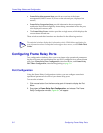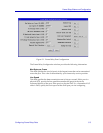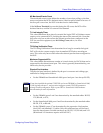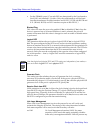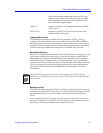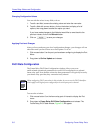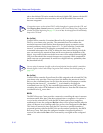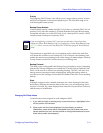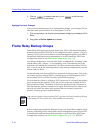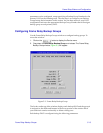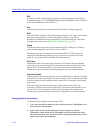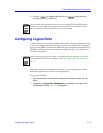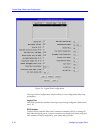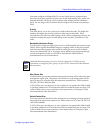
Frame Relay Status and Configuration
5-10 Configuring Frame Relay Ports
above the deÞned CIR can be marked as discard eligible (DE); frames with the DE
bit set are considered to be excess data, and will be discarded if the network
becomes congested.
B
C
(In/Out)
Use this Þeld to enter the Committed Burst Size (B
C
) assigned to the selected
DLCI by your frame relay provider. The committed burst size deÞnes the
maximum amount of data (in bits) that the network agrees to transfer, under
normal conditions, during a time interval T
C
. T
C
(also called the Òbandwidth
intervalÓ) is calculated by dividing the committed burst size (B
C
) by the
committed information rate (CIR); it deÞnes the time interval during which the
user can send only B
C
amount of data and B
E
excess data (see deÞnition of B
E
,
below). Any trafÞc which exceeds this burst rate will be marked discard eligible
(DE), and discarded if the network becomes too congested. While sustained B
C
trafÞc rates are not guaranteed, B
C
trafÞc has a higher delivery probability than
B
E
(described below).
B
E
(In/Out)
Use this Þeld to enter the Excess Burst Size (B
E
) assigned to the selected DLCI by
your frame relay provider. The excess burst size deÞnes the amount of data (in
bits) over the committed burst size (B
C
) that the network will attempt to transfer
during the time interval T
C
(remember, T
C
is calculated by dividing the
committed burst size (B
C
) by the committed information rate (CIR)). Any data
exceeding this value will be buffered in the FRX device. Note that DE frames are
considered to be B
E
excess data.
BECN
The BECN Recovery Count provides a means for controlling the rate of return to
maximum trafÞc ßow after it has been reduced due to congestion. If a packet is
received on the selected DLCI with the BECN (backward explicit congestion
notiÞcation) bit set, the conÞgured B
E
Out value will be ignored and the effective
value will become zero (limiting trafÞc ßow to the value conÞgured for B
C
Out).
This limit will remain in place until the DLCI receives a speciÞed number of
sequential packets without the BECN bit set: the number speciÞed by the BECN
Recovery Count. Each time the conÞgured number of sequential packets is
received, the effective B
E
Out will be increased by one-eighth of the conÞgured
value.
TIP
If congestion occurs on the selected DLCI while throughput is greater than the CIR, and
the Outgoing Rate Control parameter (settable via the Frame Relay Port ConÞguration
window, described beginning on page 5-2) is set to Yes, the throughput will immediately
drop to the CIR level.
TIP
You can view the amount of trafÞc on the selected physical interface which is marked as
discard eligible via the Frame Relay Congestion Stats window, described beginning on
page 5-22.



